Accounting Theory and Current Issues: Analysis and Recommendations
VerifiedAdded on 2021/01/01
|13
|4027
|488
Report
AI Summary
This report comprehensively analyzes accounting theory and its practical applications. It begins by examining the qualitative characteristics of financial reporting and then delves into the perspectives of various theories regarding government decisions on regulations, specifically concerning Corporate Social Responsibility (CSR). The report then explores the revaluation models for fixed assets, contrasting the cost and revaluation models, and discusses how directors can be motivated regarding asset valuation. It also analyzes the effects of non-revaluation decisions on financial statements and shareholder wealth. Furthermore, the report includes a case study involving impairment procedures and concludes with an examination of accounting standards for leases, comparing former and new standards and the rationale behind the changes. The report provides insights into the complexities of accounting theory and its impact on financial reporting and decision-making.

Accounting Theory and
Current Issues
Current Issues
Paraphrase This Document
Need a fresh take? Get an instant paraphrase of this document with our AI Paraphraser
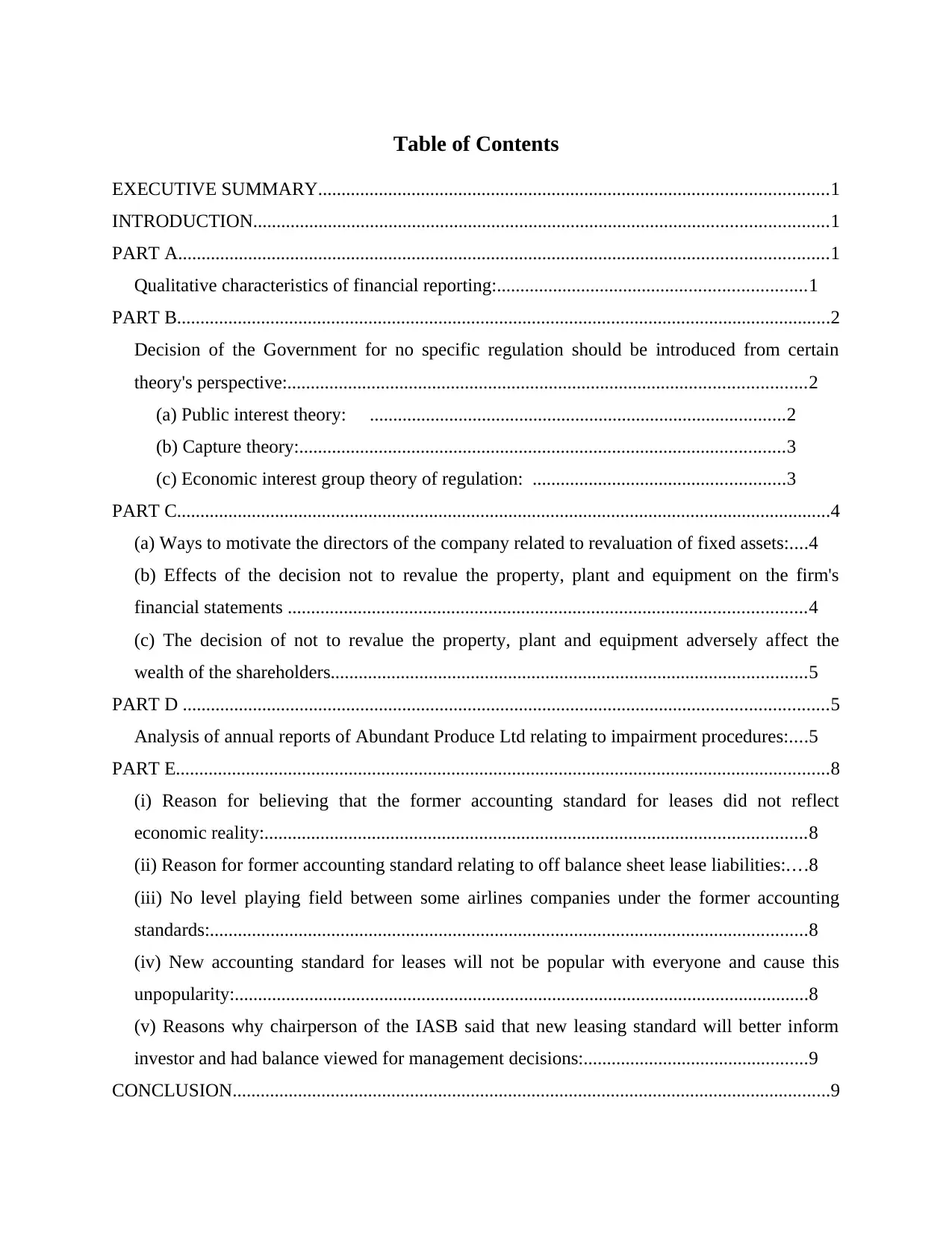
Table of Contents
EXECUTIVE SUMMARY.............................................................................................................1
INTRODUCTION...........................................................................................................................1
PART A...........................................................................................................................................1
Qualitative characteristics of financial reporting:..................................................................1
PART B............................................................................................................................................2
Decision of the Government for no specific regulation should be introduced from certain
theory's perspective:...............................................................................................................2
(a) Public interest theory: .........................................................................................2
(b) Capture theory:........................................................................................................3
(c) Economic interest group theory of regulation: ......................................................3
PART C............................................................................................................................................4
(a) Ways to motivate the directors of the company related to revaluation of fixed assets:....4
(b) Effects of the decision not to revalue the property, plant and equipment on the firm's
financial statements ...............................................................................................................4
(c) The decision of not to revalue the property, plant and equipment adversely affect the
wealth of the shareholders......................................................................................................5
PART D ..........................................................................................................................................5
Analysis of annual reports of Abundant Produce Ltd relating to impairment procedures:....5
PART E............................................................................................................................................8
(i) Reason for believing that the former accounting standard for leases did not reflect
economic reality:....................................................................................................................8
(ii) Reason for former accounting standard relating to off balance sheet lease liabilities:....8
(iii) No level playing field between some airlines companies under the former accounting
standards:................................................................................................................................8
(iv) New accounting standard for leases will not be popular with everyone and cause this
unpopularity:...........................................................................................................................8
(v) Reasons why chairperson of the IASB said that new leasing standard will better inform
investor and had balance viewed for management decisions:................................................9
CONCLUSION................................................................................................................................9
EXECUTIVE SUMMARY.............................................................................................................1
INTRODUCTION...........................................................................................................................1
PART A...........................................................................................................................................1
Qualitative characteristics of financial reporting:..................................................................1
PART B............................................................................................................................................2
Decision of the Government for no specific regulation should be introduced from certain
theory's perspective:...............................................................................................................2
(a) Public interest theory: .........................................................................................2
(b) Capture theory:........................................................................................................3
(c) Economic interest group theory of regulation: ......................................................3
PART C............................................................................................................................................4
(a) Ways to motivate the directors of the company related to revaluation of fixed assets:....4
(b) Effects of the decision not to revalue the property, plant and equipment on the firm's
financial statements ...............................................................................................................4
(c) The decision of not to revalue the property, plant and equipment adversely affect the
wealth of the shareholders......................................................................................................5
PART D ..........................................................................................................................................5
Analysis of annual reports of Abundant Produce Ltd relating to impairment procedures:....5
PART E............................................................................................................................................8
(i) Reason for believing that the former accounting standard for leases did not reflect
economic reality:....................................................................................................................8
(ii) Reason for former accounting standard relating to off balance sheet lease liabilities:....8
(iii) No level playing field between some airlines companies under the former accounting
standards:................................................................................................................................8
(iv) New accounting standard for leases will not be popular with everyone and cause this
unpopularity:...........................................................................................................................8
(v) Reasons why chairperson of the IASB said that new leasing standard will better inform
investor and had balance viewed for management decisions:................................................9
CONCLUSION................................................................................................................................9
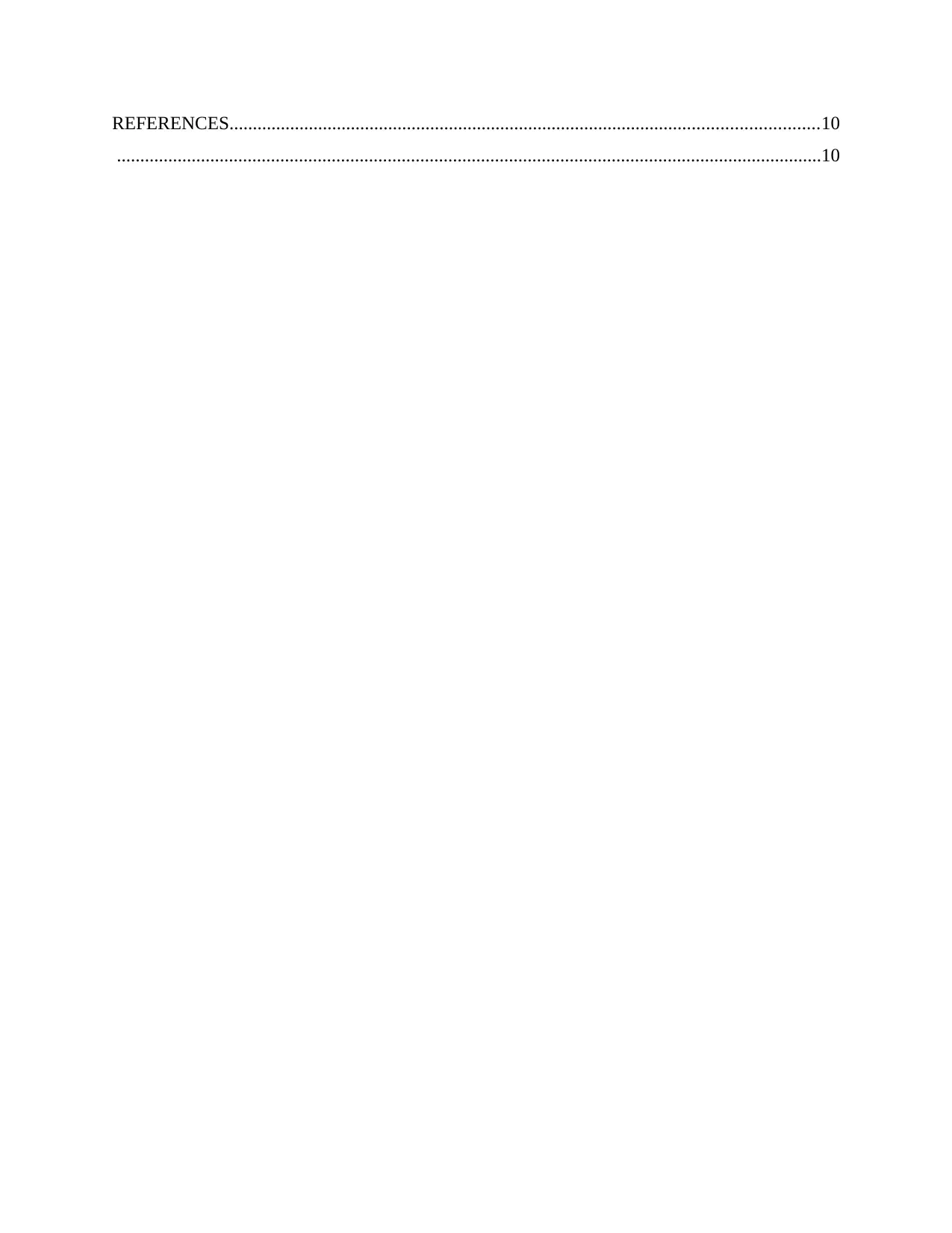
REFERENCES..............................................................................................................................10
.......................................................................................................................................................10
.......................................................................................................................................................10
⊘ This is a preview!⊘
Do you want full access?
Subscribe today to unlock all pages.

Trusted by 1+ million students worldwide
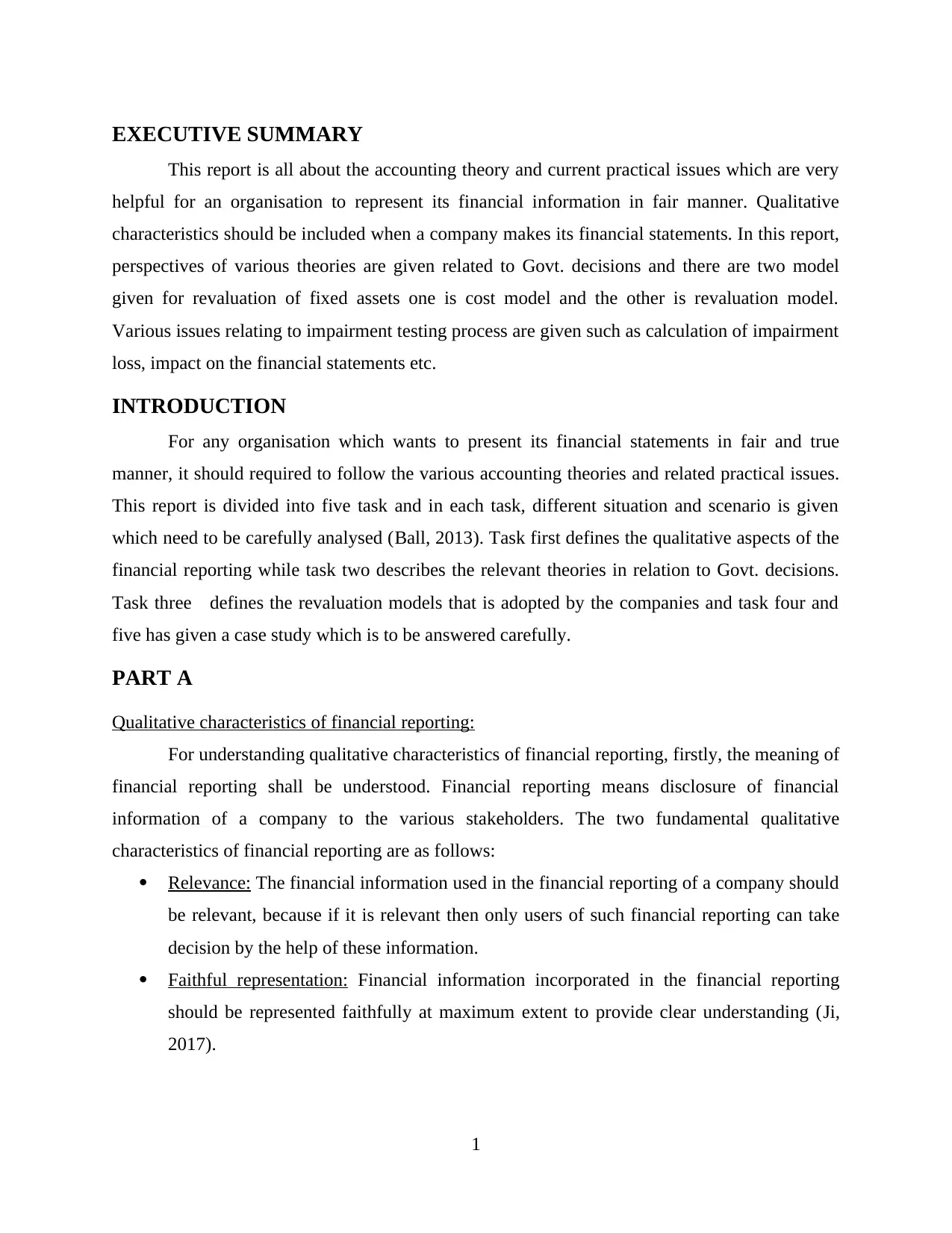
EXECUTIVE SUMMARY
This report is all about the accounting theory and current practical issues which are very
helpful for an organisation to represent its financial information in fair manner. Qualitative
characteristics should be included when a company makes its financial statements. In this report,
perspectives of various theories are given related to Govt. decisions and there are two model
given for revaluation of fixed assets one is cost model and the other is revaluation model.
Various issues relating to impairment testing process are given such as calculation of impairment
loss, impact on the financial statements etc.
INTRODUCTION
For any organisation which wants to present its financial statements in fair and true
manner, it should required to follow the various accounting theories and related practical issues.
This report is divided into five task and in each task, different situation and scenario is given
which need to be carefully analysed (Ball, 2013). Task first defines the qualitative aspects of the
financial reporting while task two describes the relevant theories in relation to Govt. decisions.
Task three defines the revaluation models that is adopted by the companies and task four and
five has given a case study which is to be answered carefully.
PART A
Qualitative characteristics of financial reporting:
For understanding qualitative characteristics of financial reporting, firstly, the meaning of
financial reporting shall be understood. Financial reporting means disclosure of financial
information of a company to the various stakeholders. The two fundamental qualitative
characteristics of financial reporting are as follows:
Relevance: The financial information used in the financial reporting of a company should
be relevant, because if it is relevant then only users of such financial reporting can take
decision by the help of these information.
Faithful representation: Financial information incorporated in the financial reporting
should be represented faithfully at maximum extent to provide clear understanding (Ji,
2017).
1
This report is all about the accounting theory and current practical issues which are very
helpful for an organisation to represent its financial information in fair manner. Qualitative
characteristics should be included when a company makes its financial statements. In this report,
perspectives of various theories are given related to Govt. decisions and there are two model
given for revaluation of fixed assets one is cost model and the other is revaluation model.
Various issues relating to impairment testing process are given such as calculation of impairment
loss, impact on the financial statements etc.
INTRODUCTION
For any organisation which wants to present its financial statements in fair and true
manner, it should required to follow the various accounting theories and related practical issues.
This report is divided into five task and in each task, different situation and scenario is given
which need to be carefully analysed (Ball, 2013). Task first defines the qualitative aspects of the
financial reporting while task two describes the relevant theories in relation to Govt. decisions.
Task three defines the revaluation models that is adopted by the companies and task four and
five has given a case study which is to be answered carefully.
PART A
Qualitative characteristics of financial reporting:
For understanding qualitative characteristics of financial reporting, firstly, the meaning of
financial reporting shall be understood. Financial reporting means disclosure of financial
information of a company to the various stakeholders. The two fundamental qualitative
characteristics of financial reporting are as follows:
Relevance: The financial information used in the financial reporting of a company should
be relevant, because if it is relevant then only users of such financial reporting can take
decision by the help of these information.
Faithful representation: Financial information incorporated in the financial reporting
should be represented faithfully at maximum extent to provide clear understanding (Ji,
2017).
1
Paraphrase This Document
Need a fresh take? Get an instant paraphrase of this document with our AI Paraphraser

PART B
Decision of the Government for no specific regulation should be introduced from certain theory's
perspective:
There are three types of theories, the views of these theories (perspective) should be
considered in relation to any regulation, when government takes any decision on any regulations
whether it should be included or not in any legislation. There is a a issue given related to this
which are as follows:
Overview of given issue:
As given in the question, in 2006, government (Govt.) wants to decide whether there is a
requirement of insertion of some regulations related to corporate social responsibility (CSR) in
corporation act or not. For this, Govt. has conduct an inquiry into CSR and this results in no need
of insertion or addition in the act, because Govt. thinks that there is market forces which
influence the companies to do the right thing. This is because, if company did not look after the
environment then customers shall not accept the products of a company (Shields, 2015).
(a) Public interest theory:
For understanding the perspective of this theory related to above decision of Govt.,
firstly, meaning of public interest theory should be understand. Public Interest Theory is the
general terms of any legislation or regulation which defines the provisions related to protection
and benefits of the general public as whole. According to this theory, government has a power to
make rules and regulations to improve the market and enhance healthy competition in the market
for the benefits of public.
Analysis of decision of Govt. in context of Public Interest Theory:
In the above issue, Govt. has decided that there is no need to add regulations in the
Corporations Act related to Corporate social responsibility (CSR). But after observing the above
issue, additions in the Corporation Act must be necessary because market sources are the
temporary solution for CSR related problem. In other hand, insertion of regulations in
Corporation Act has a permanent solution and also an enactment has a legal power to levy
penalty if there is a non compliance of CSR provisions. Due to the absence of these regulations,
there may be a chances that companies may take advantages of this in fulfilling their objectives
by not considering corporate social responsibilities. Also perhaps, there may be chances that
2
Decision of the Government for no specific regulation should be introduced from certain theory's
perspective:
There are three types of theories, the views of these theories (perspective) should be
considered in relation to any regulation, when government takes any decision on any regulations
whether it should be included or not in any legislation. There is a a issue given related to this
which are as follows:
Overview of given issue:
As given in the question, in 2006, government (Govt.) wants to decide whether there is a
requirement of insertion of some regulations related to corporate social responsibility (CSR) in
corporation act or not. For this, Govt. has conduct an inquiry into CSR and this results in no need
of insertion or addition in the act, because Govt. thinks that there is market forces which
influence the companies to do the right thing. This is because, if company did not look after the
environment then customers shall not accept the products of a company (Shields, 2015).
(a) Public interest theory:
For understanding the perspective of this theory related to above decision of Govt.,
firstly, meaning of public interest theory should be understand. Public Interest Theory is the
general terms of any legislation or regulation which defines the provisions related to protection
and benefits of the general public as whole. According to this theory, government has a power to
make rules and regulations to improve the market and enhance healthy competition in the market
for the benefits of public.
Analysis of decision of Govt. in context of Public Interest Theory:
In the above issue, Govt. has decided that there is no need to add regulations in the
Corporations Act related to Corporate social responsibility (CSR). But after observing the above
issue, additions in the Corporation Act must be necessary because market sources are the
temporary solution for CSR related problem. In other hand, insertion of regulations in
Corporation Act has a permanent solution and also an enactment has a legal power to levy
penalty if there is a non compliance of CSR provisions. Due to the absence of these regulations,
there may be a chances that companies may take advantages of this in fulfilling their objectives
by not considering corporate social responsibilities. Also perhaps, there may be chances that
2
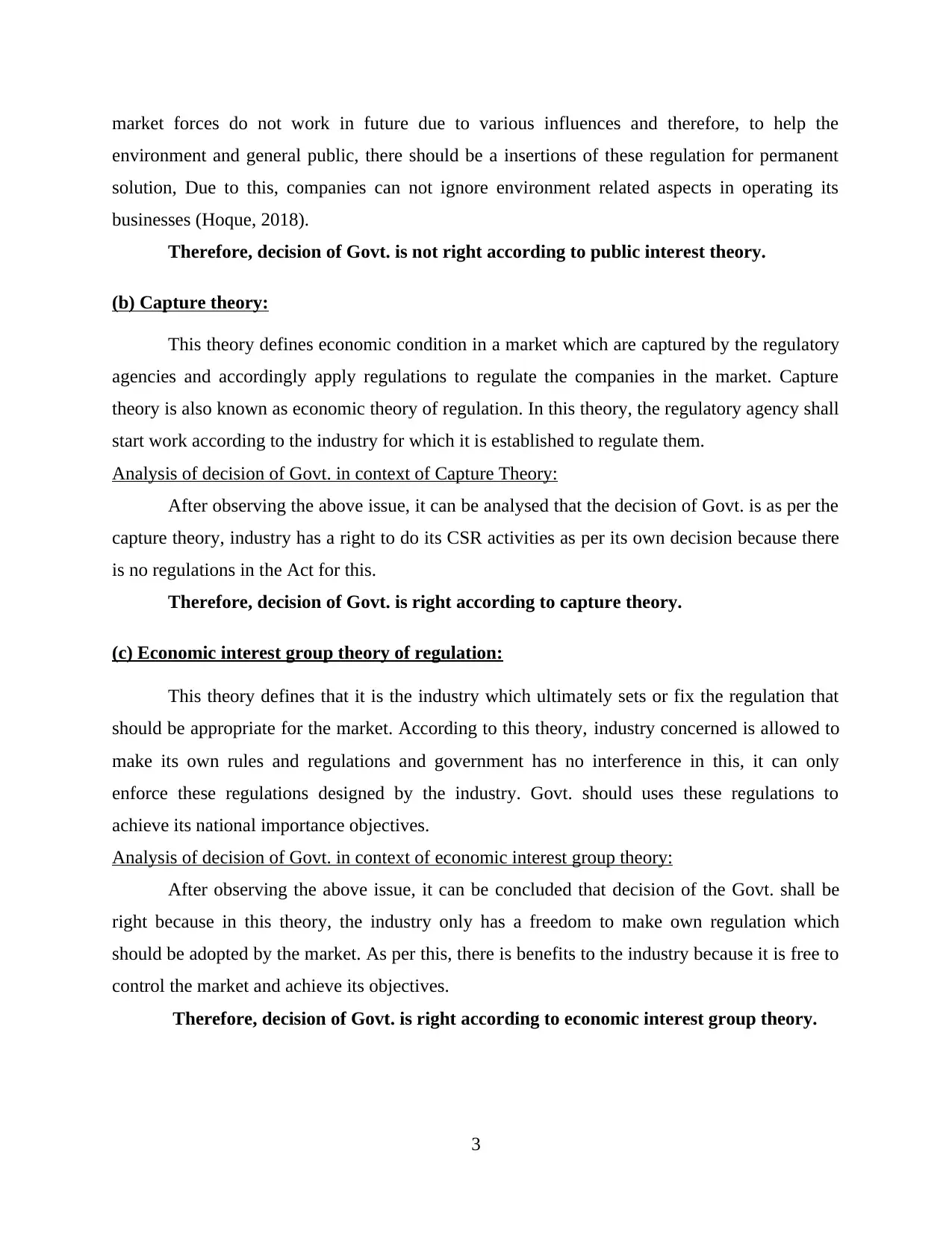
market forces do not work in future due to various influences and therefore, to help the
environment and general public, there should be a insertions of these regulation for permanent
solution, Due to this, companies can not ignore environment related aspects in operating its
businesses (Hoque, 2018).
Therefore, decision of Govt. is not right according to public interest theory.
(b) Capture theory:
This theory defines economic condition in a market which are captured by the regulatory
agencies and accordingly apply regulations to regulate the companies in the market. Capture
theory is also known as economic theory of regulation. In this theory, the regulatory agency shall
start work according to the industry for which it is established to regulate them.
Analysis of decision of Govt. in context of Capture Theory:
After observing the above issue, it can be analysed that the decision of Govt. is as per the
capture theory, industry has a right to do its CSR activities as per its own decision because there
is no regulations in the Act for this.
Therefore, decision of Govt. is right according to capture theory.
(c) Economic interest group theory of regulation:
This theory defines that it is the industry which ultimately sets or fix the regulation that
should be appropriate for the market. According to this theory, industry concerned is allowed to
make its own rules and regulations and government has no interference in this, it can only
enforce these regulations designed by the industry. Govt. should uses these regulations to
achieve its national importance objectives.
Analysis of decision of Govt. in context of economic interest group theory:
After observing the above issue, it can be concluded that decision of the Govt. shall be
right because in this theory, the industry only has a freedom to make own regulation which
should be adopted by the market. As per this, there is benefits to the industry because it is free to
control the market and achieve its objectives.
Therefore, decision of Govt. is right according to economic interest group theory.
3
environment and general public, there should be a insertions of these regulation for permanent
solution, Due to this, companies can not ignore environment related aspects in operating its
businesses (Hoque, 2018).
Therefore, decision of Govt. is not right according to public interest theory.
(b) Capture theory:
This theory defines economic condition in a market which are captured by the regulatory
agencies and accordingly apply regulations to regulate the companies in the market. Capture
theory is also known as economic theory of regulation. In this theory, the regulatory agency shall
start work according to the industry for which it is established to regulate them.
Analysis of decision of Govt. in context of Capture Theory:
After observing the above issue, it can be analysed that the decision of Govt. is as per the
capture theory, industry has a right to do its CSR activities as per its own decision because there
is no regulations in the Act for this.
Therefore, decision of Govt. is right according to capture theory.
(c) Economic interest group theory of regulation:
This theory defines that it is the industry which ultimately sets or fix the regulation that
should be appropriate for the market. According to this theory, industry concerned is allowed to
make its own rules and regulations and government has no interference in this, it can only
enforce these regulations designed by the industry. Govt. should uses these regulations to
achieve its national importance objectives.
Analysis of decision of Govt. in context of economic interest group theory:
After observing the above issue, it can be concluded that decision of the Govt. shall be
right because in this theory, the industry only has a freedom to make own regulation which
should be adopted by the market. As per this, there is benefits to the industry because it is free to
control the market and achieve its objectives.
Therefore, decision of Govt. is right according to economic interest group theory.
3
⊘ This is a preview!⊘
Do you want full access?
Subscribe today to unlock all pages.

Trusted by 1+ million students worldwide
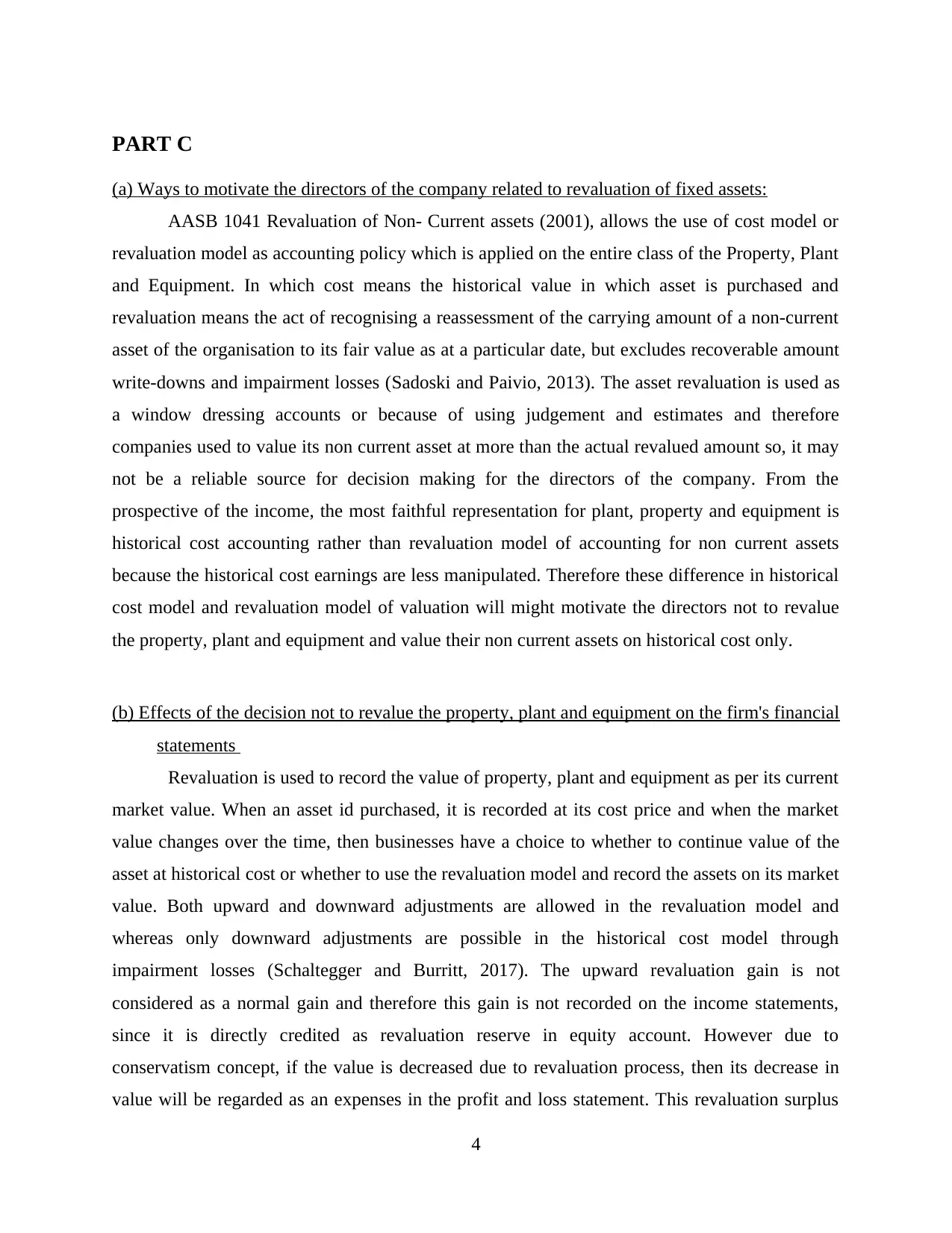
PART C
(a) Ways to motivate the directors of the company related to revaluation of fixed assets:
AASB 1041 Revaluation of Non- Current assets (2001), allows the use of cost model or
revaluation model as accounting policy which is applied on the entire class of the Property, Plant
and Equipment. In which cost means the historical value in which asset is purchased and
revaluation means the act of recognising a reassessment of the carrying amount of a non-current
asset of the organisation to its fair value as at a particular date, but excludes recoverable amount
write-downs and impairment losses (Sadoski and Paivio, 2013). The asset revaluation is used as
a window dressing accounts or because of using judgement and estimates and therefore
companies used to value its non current asset at more than the actual revalued amount so, it may
not be a reliable source for decision making for the directors of the company. From the
prospective of the income, the most faithful representation for plant, property and equipment is
historical cost accounting rather than revaluation model of accounting for non current assets
because the historical cost earnings are less manipulated. Therefore these difference in historical
cost model and revaluation model of valuation will might motivate the directors not to revalue
the property, plant and equipment and value their non current assets on historical cost only.
(b) Effects of the decision not to revalue the property, plant and equipment on the firm's financial
statements
Revaluation is used to record the value of property, plant and equipment as per its current
market value. When an asset id purchased, it is recorded at its cost price and when the market
value changes over the time, then businesses have a choice to whether to continue value of the
asset at historical cost or whether to use the revaluation model and record the assets on its market
value. Both upward and downward adjustments are allowed in the revaluation model and
whereas only downward adjustments are possible in the historical cost model through
impairment losses (Schaltegger and Burritt, 2017). The upward revaluation gain is not
considered as a normal gain and therefore this gain is not recorded on the income statements,
since it is directly credited as revaluation reserve in equity account. However due to
conservatism concept, if the value is decreased due to revaluation process, then its decrease in
value will be regarded as an expenses in the profit and loss statement. This revaluation surplus
4
(a) Ways to motivate the directors of the company related to revaluation of fixed assets:
AASB 1041 Revaluation of Non- Current assets (2001), allows the use of cost model or
revaluation model as accounting policy which is applied on the entire class of the Property, Plant
and Equipment. In which cost means the historical value in which asset is purchased and
revaluation means the act of recognising a reassessment of the carrying amount of a non-current
asset of the organisation to its fair value as at a particular date, but excludes recoverable amount
write-downs and impairment losses (Sadoski and Paivio, 2013). The asset revaluation is used as
a window dressing accounts or because of using judgement and estimates and therefore
companies used to value its non current asset at more than the actual revalued amount so, it may
not be a reliable source for decision making for the directors of the company. From the
prospective of the income, the most faithful representation for plant, property and equipment is
historical cost accounting rather than revaluation model of accounting for non current assets
because the historical cost earnings are less manipulated. Therefore these difference in historical
cost model and revaluation model of valuation will might motivate the directors not to revalue
the property, plant and equipment and value their non current assets on historical cost only.
(b) Effects of the decision not to revalue the property, plant and equipment on the firm's financial
statements
Revaluation is used to record the value of property, plant and equipment as per its current
market value. When an asset id purchased, it is recorded at its cost price and when the market
value changes over the time, then businesses have a choice to whether to continue value of the
asset at historical cost or whether to use the revaluation model and record the assets on its market
value. Both upward and downward adjustments are allowed in the revaluation model and
whereas only downward adjustments are possible in the historical cost model through
impairment losses (Schaltegger and Burritt, 2017). The upward revaluation gain is not
considered as a normal gain and therefore this gain is not recorded on the income statements,
since it is directly credited as revaluation reserve in equity account. However due to
conservatism concept, if the value is decreased due to revaluation process, then its decrease in
value will be regarded as an expenses in the profit and loss statement. This revaluation surplus
4
Paraphrase This Document
Need a fresh take? Get an instant paraphrase of this document with our AI Paraphraser
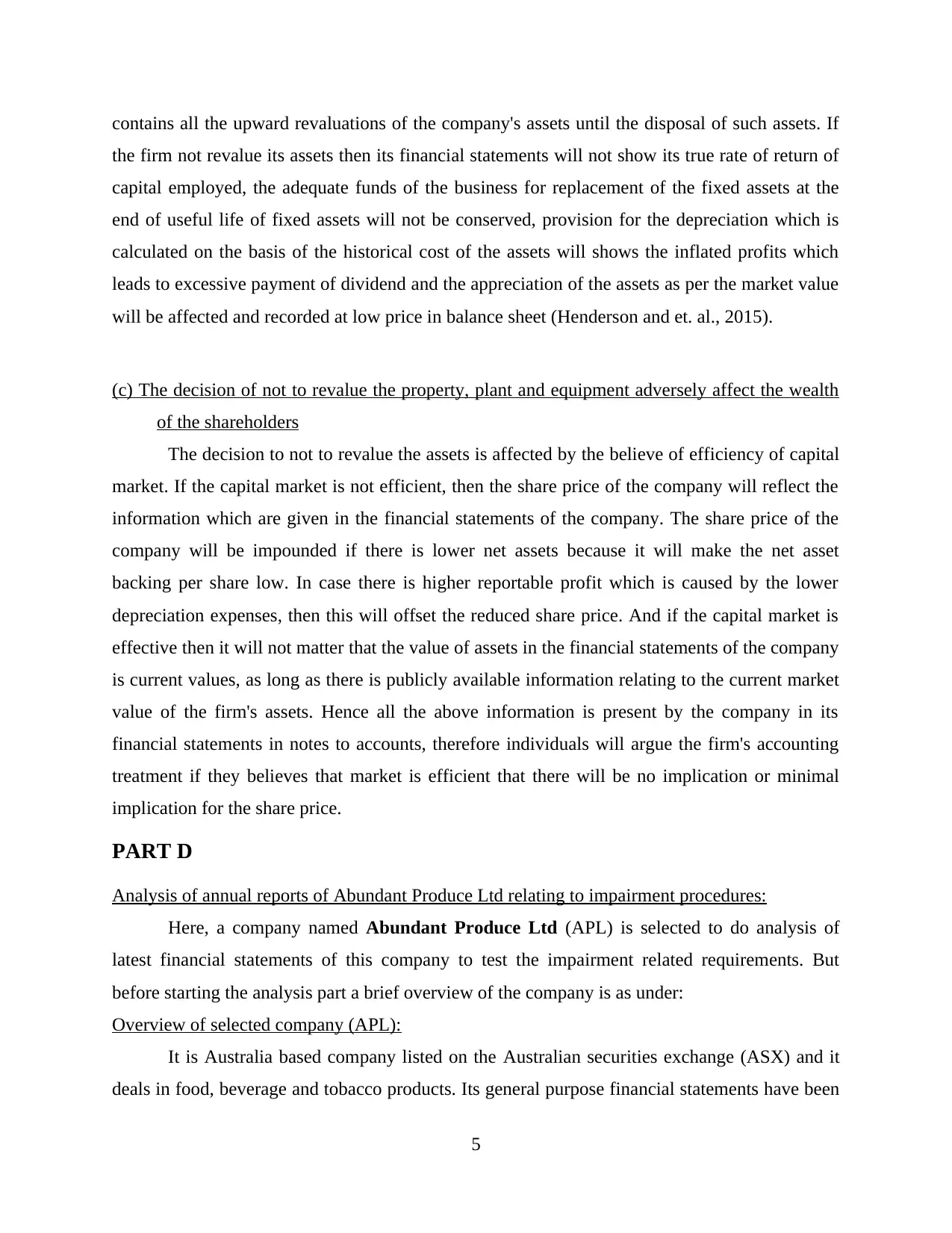
contains all the upward revaluations of the company's assets until the disposal of such assets. If
the firm not revalue its assets then its financial statements will not show its true rate of return of
capital employed, the adequate funds of the business for replacement of the fixed assets at the
end of useful life of fixed assets will not be conserved, provision for the depreciation which is
calculated on the basis of the historical cost of the assets will shows the inflated profits which
leads to excessive payment of dividend and the appreciation of the assets as per the market value
will be affected and recorded at low price in balance sheet (Henderson and et. al., 2015).
(c) The decision of not to revalue the property, plant and equipment adversely affect the wealth
of the shareholders
The decision to not to revalue the assets is affected by the believe of efficiency of capital
market. If the capital market is not efficient, then the share price of the company will reflect the
information which are given in the financial statements of the company. The share price of the
company will be impounded if there is lower net assets because it will make the net asset
backing per share low. In case there is higher reportable profit which is caused by the lower
depreciation expenses, then this will offset the reduced share price. And if the capital market is
effective then it will not matter that the value of assets in the financial statements of the company
is current values, as long as there is publicly available information relating to the current market
value of the firm's assets. Hence all the above information is present by the company in its
financial statements in notes to accounts, therefore individuals will argue the firm's accounting
treatment if they believes that market is efficient that there will be no implication or minimal
implication for the share price.
PART D
Analysis of annual reports of Abundant Produce Ltd relating to impairment procedures:
Here, a company named Abundant Produce Ltd (APL) is selected to do analysis of
latest financial statements of this company to test the impairment related requirements. But
before starting the analysis part a brief overview of the company is as under:
Overview of selected company (APL):
It is Australia based company listed on the Australian securities exchange (ASX) and it
deals in food, beverage and tobacco products. Its general purpose financial statements have been
5
the firm not revalue its assets then its financial statements will not show its true rate of return of
capital employed, the adequate funds of the business for replacement of the fixed assets at the
end of useful life of fixed assets will not be conserved, provision for the depreciation which is
calculated on the basis of the historical cost of the assets will shows the inflated profits which
leads to excessive payment of dividend and the appreciation of the assets as per the market value
will be affected and recorded at low price in balance sheet (Henderson and et. al., 2015).
(c) The decision of not to revalue the property, plant and equipment adversely affect the wealth
of the shareholders
The decision to not to revalue the assets is affected by the believe of efficiency of capital
market. If the capital market is not efficient, then the share price of the company will reflect the
information which are given in the financial statements of the company. The share price of the
company will be impounded if there is lower net assets because it will make the net asset
backing per share low. In case there is higher reportable profit which is caused by the lower
depreciation expenses, then this will offset the reduced share price. And if the capital market is
effective then it will not matter that the value of assets in the financial statements of the company
is current values, as long as there is publicly available information relating to the current market
value of the firm's assets. Hence all the above information is present by the company in its
financial statements in notes to accounts, therefore individuals will argue the firm's accounting
treatment if they believes that market is efficient that there will be no implication or minimal
implication for the share price.
PART D
Analysis of annual reports of Abundant Produce Ltd relating to impairment procedures:
Here, a company named Abundant Produce Ltd (APL) is selected to do analysis of
latest financial statements of this company to test the impairment related requirements. But
before starting the analysis part a brief overview of the company is as under:
Overview of selected company (APL):
It is Australia based company listed on the Australian securities exchange (ASX) and it
deals in food, beverage and tobacco products. Its general purpose financial statements have been
5
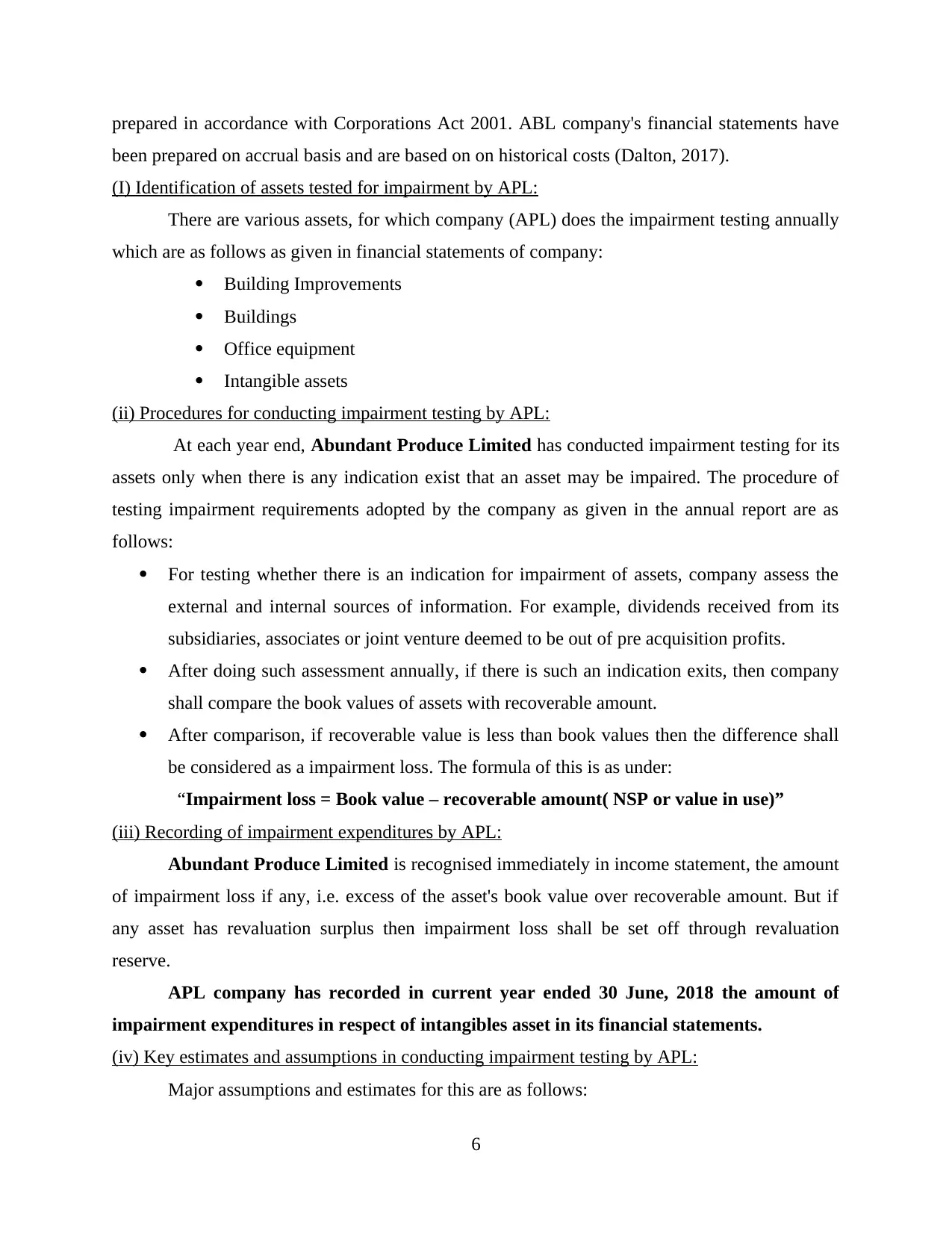
prepared in accordance with Corporations Act 2001. ABL company's financial statements have
been prepared on accrual basis and are based on on historical costs (Dalton, 2017).
(I) Identification of assets tested for impairment by APL:
There are various assets, for which company (APL) does the impairment testing annually
which are as follows as given in financial statements of company:
Building Improvements
Buildings
Office equipment
Intangible assets
(ii) Procedures for conducting impairment testing by APL:
At each year end, Abundant Produce Limited has conducted impairment testing for its
assets only when there is any indication exist that an asset may be impaired. The procedure of
testing impairment requirements adopted by the company as given in the annual report are as
follows:
For testing whether there is an indication for impairment of assets, company assess the
external and internal sources of information. For example, dividends received from its
subsidiaries, associates or joint venture deemed to be out of pre acquisition profits.
After doing such assessment annually, if there is such an indication exits, then company
shall compare the book values of assets with recoverable amount.
After comparison, if recoverable value is less than book values then the difference shall
be considered as a impairment loss. The formula of this is as under:
“Impairment loss = Book value – recoverable amount( NSP or value in use)”
(iii) Recording of impairment expenditures by APL:
Abundant Produce Limited is recognised immediately in income statement, the amount
of impairment loss if any, i.e. excess of the asset's book value over recoverable amount. But if
any asset has revaluation surplus then impairment loss shall be set off through revaluation
reserve.
APL company has recorded in current year ended 30 June, 2018 the amount of
impairment expenditures in respect of intangibles asset in its financial statements.
(iv) Key estimates and assumptions in conducting impairment testing by APL:
Major assumptions and estimates for this are as follows:
6
been prepared on accrual basis and are based on on historical costs (Dalton, 2017).
(I) Identification of assets tested for impairment by APL:
There are various assets, for which company (APL) does the impairment testing annually
which are as follows as given in financial statements of company:
Building Improvements
Buildings
Office equipment
Intangible assets
(ii) Procedures for conducting impairment testing by APL:
At each year end, Abundant Produce Limited has conducted impairment testing for its
assets only when there is any indication exist that an asset may be impaired. The procedure of
testing impairment requirements adopted by the company as given in the annual report are as
follows:
For testing whether there is an indication for impairment of assets, company assess the
external and internal sources of information. For example, dividends received from its
subsidiaries, associates or joint venture deemed to be out of pre acquisition profits.
After doing such assessment annually, if there is such an indication exits, then company
shall compare the book values of assets with recoverable amount.
After comparison, if recoverable value is less than book values then the difference shall
be considered as a impairment loss. The formula of this is as under:
“Impairment loss = Book value – recoverable amount( NSP or value in use)”
(iii) Recording of impairment expenditures by APL:
Abundant Produce Limited is recognised immediately in income statement, the amount
of impairment loss if any, i.e. excess of the asset's book value over recoverable amount. But if
any asset has revaluation surplus then impairment loss shall be set off through revaluation
reserve.
APL company has recorded in current year ended 30 June, 2018 the amount of
impairment expenditures in respect of intangibles asset in its financial statements.
(iv) Key estimates and assumptions in conducting impairment testing by APL:
Major assumptions and estimates for this are as follows:
6
⊘ This is a preview!⊘
Do you want full access?
Subscribe today to unlock all pages.

Trusted by 1+ million students worldwide
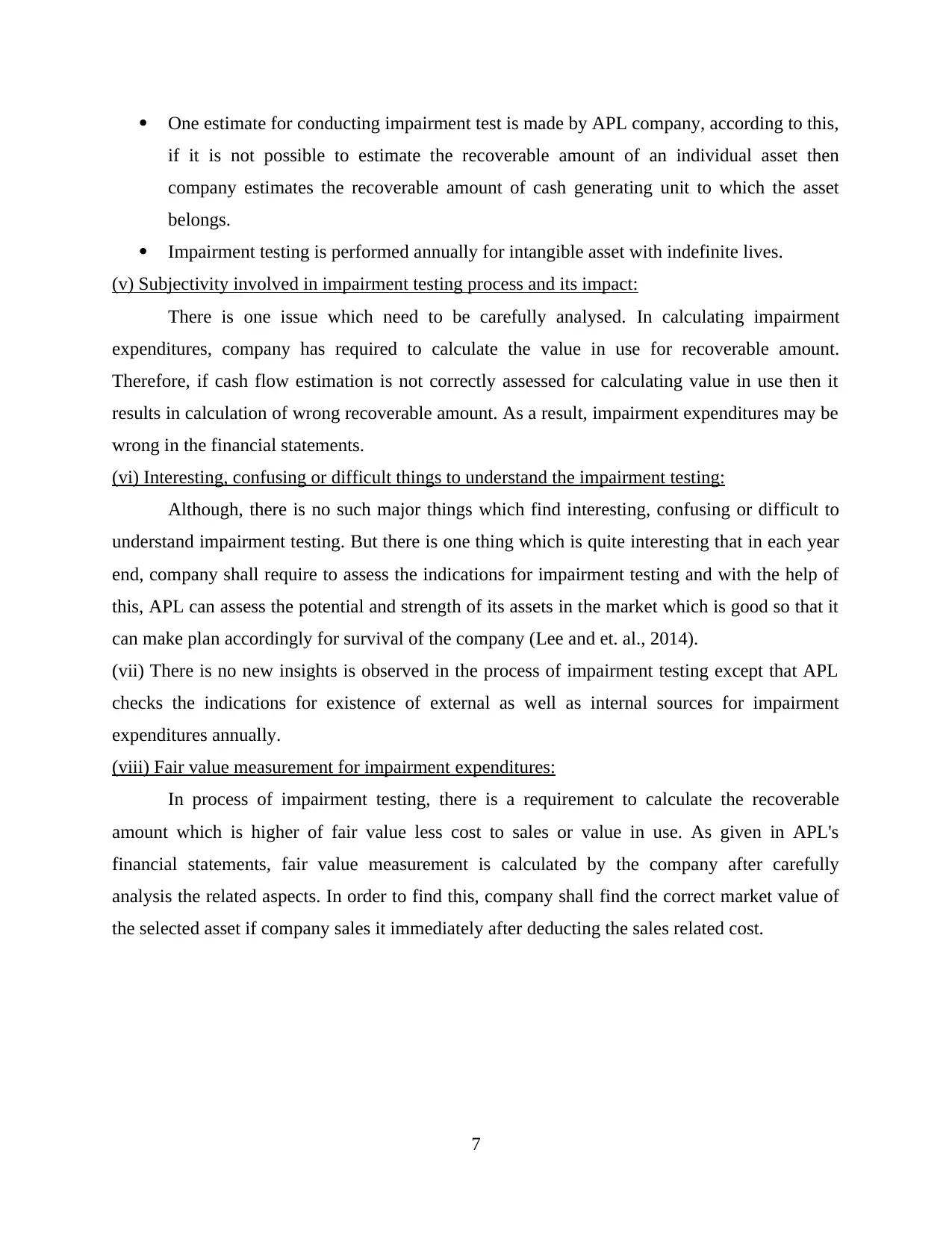
One estimate for conducting impairment test is made by APL company, according to this,
if it is not possible to estimate the recoverable amount of an individual asset then
company estimates the recoverable amount of cash generating unit to which the asset
belongs.
Impairment testing is performed annually for intangible asset with indefinite lives.
(v) Subjectivity involved in impairment testing process and its impact:
There is one issue which need to be carefully analysed. In calculating impairment
expenditures, company has required to calculate the value in use for recoverable amount.
Therefore, if cash flow estimation is not correctly assessed for calculating value in use then it
results in calculation of wrong recoverable amount. As a result, impairment expenditures may be
wrong in the financial statements.
(vi) Interesting, confusing or difficult things to understand the impairment testing:
Although, there is no such major things which find interesting, confusing or difficult to
understand impairment testing. But there is one thing which is quite interesting that in each year
end, company shall require to assess the indications for impairment testing and with the help of
this, APL can assess the potential and strength of its assets in the market which is good so that it
can make plan accordingly for survival of the company (Lee and et. al., 2014).
(vii) There is no new insights is observed in the process of impairment testing except that APL
checks the indications for existence of external as well as internal sources for impairment
expenditures annually.
(viii) Fair value measurement for impairment expenditures:
In process of impairment testing, there is a requirement to calculate the recoverable
amount which is higher of fair value less cost to sales or value in use. As given in APL's
financial statements, fair value measurement is calculated by the company after carefully
analysis the related aspects. In order to find this, company shall find the correct market value of
the selected asset if company sales it immediately after deducting the sales related cost.
7
if it is not possible to estimate the recoverable amount of an individual asset then
company estimates the recoverable amount of cash generating unit to which the asset
belongs.
Impairment testing is performed annually for intangible asset with indefinite lives.
(v) Subjectivity involved in impairment testing process and its impact:
There is one issue which need to be carefully analysed. In calculating impairment
expenditures, company has required to calculate the value in use for recoverable amount.
Therefore, if cash flow estimation is not correctly assessed for calculating value in use then it
results in calculation of wrong recoverable amount. As a result, impairment expenditures may be
wrong in the financial statements.
(vi) Interesting, confusing or difficult things to understand the impairment testing:
Although, there is no such major things which find interesting, confusing or difficult to
understand impairment testing. But there is one thing which is quite interesting that in each year
end, company shall require to assess the indications for impairment testing and with the help of
this, APL can assess the potential and strength of its assets in the market which is good so that it
can make plan accordingly for survival of the company (Lee and et. al., 2014).
(vii) There is no new insights is observed in the process of impairment testing except that APL
checks the indications for existence of external as well as internal sources for impairment
expenditures annually.
(viii) Fair value measurement for impairment expenditures:
In process of impairment testing, there is a requirement to calculate the recoverable
amount which is higher of fair value less cost to sales or value in use. As given in APL's
financial statements, fair value measurement is calculated by the company after carefully
analysis the related aspects. In order to find this, company shall find the correct market value of
the selected asset if company sales it immediately after deducting the sales related cost.
7
Paraphrase This Document
Need a fresh take? Get an instant paraphrase of this document with our AI Paraphraser

PART E
(i) Reason for believing that the former accounting standard for leases did not reflect economic
reality:
The current lease accounting under IAS 17 and FAS 13 does not require the operating
lease to be featured on the organisation's balance sheet and therefore many assets and the
liabilities resulted are not presented in the financial statements of the organisation. In the
estimation made by the IASB, 85% of the total commitment of US$ 3.3 trillion of lease are not
appeared in the balance sheet. This will caused the problems for the investors and the financial
analysts. Therefore the chairperson of the IASB believes that the former accounting standards for
the lease did not reflect the economic reality.
(ii) Reason for former accounting standard relating to off balance sheet lease liabilities:
In the former accounting standard, the operating lease does not requires to be featured on
the company's statement of financial position. So the assets and resulting liabilities will not be
represented on the financial statements of the company. Therefore due to the above reason,
reporting entity's off balance sheet lease liabilities were up to 66 times greater than the debt
reported on their balance sheet.
(iii) No level playing field between some airlines companies under the former accounting
standards:
The current accounting for the leases had leads to a lack of comparability. Airlines
companies fleet looks very differently from its competitors that borrows to purchase many of
their fleet, even when the financial obligations of these companies are very similar. These
airlines companies had the vast majority of lease contracts which are not recorded on the balance
sheet, even though they involve the heavy element of financing. Therefore there is no level
playing field between the airlines companies under the former accounting standards since the off
balance sheet financing numbers can be quite substantial (Hirschi, 2017).
(iv) New accounting standard for leases will not be popular with everyone and cause this
unpopularity:
An accounting procedure will always reflect the underlying economics. It is very difficult
to implement the new accounting standards immediately and therefore it always preferable to
implement the new accounting standard in steps. The chairperson of the IASB said that the new
8
(i) Reason for believing that the former accounting standard for leases did not reflect economic
reality:
The current lease accounting under IAS 17 and FAS 13 does not require the operating
lease to be featured on the organisation's balance sheet and therefore many assets and the
liabilities resulted are not presented in the financial statements of the organisation. In the
estimation made by the IASB, 85% of the total commitment of US$ 3.3 trillion of lease are not
appeared in the balance sheet. This will caused the problems for the investors and the financial
analysts. Therefore the chairperson of the IASB believes that the former accounting standards for
the lease did not reflect the economic reality.
(ii) Reason for former accounting standard relating to off balance sheet lease liabilities:
In the former accounting standard, the operating lease does not requires to be featured on
the company's statement of financial position. So the assets and resulting liabilities will not be
represented on the financial statements of the company. Therefore due to the above reason,
reporting entity's off balance sheet lease liabilities were up to 66 times greater than the debt
reported on their balance sheet.
(iii) No level playing field between some airlines companies under the former accounting
standards:
The current accounting for the leases had leads to a lack of comparability. Airlines
companies fleet looks very differently from its competitors that borrows to purchase many of
their fleet, even when the financial obligations of these companies are very similar. These
airlines companies had the vast majority of lease contracts which are not recorded on the balance
sheet, even though they involve the heavy element of financing. Therefore there is no level
playing field between the airlines companies under the former accounting standards since the off
balance sheet financing numbers can be quite substantial (Hirschi, 2017).
(iv) New accounting standard for leases will not be popular with everyone and cause this
unpopularity:
An accounting procedure will always reflect the underlying economics. It is very difficult
to implement the new accounting standards immediately and therefore it always preferable to
implement the new accounting standard in steps. The chairperson of the IASB said that the new
8
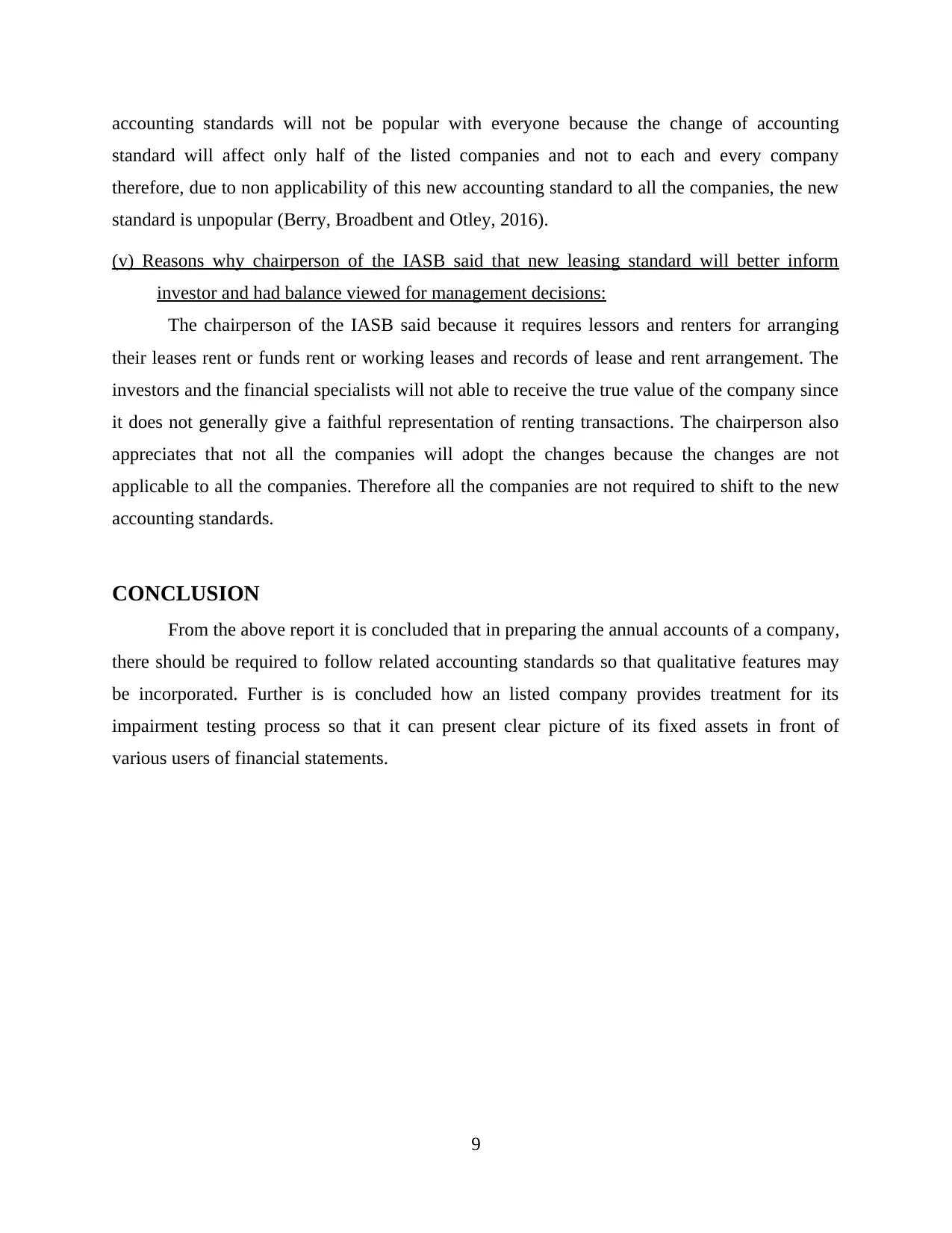
accounting standards will not be popular with everyone because the change of accounting
standard will affect only half of the listed companies and not to each and every company
therefore, due to non applicability of this new accounting standard to all the companies, the new
standard is unpopular (Berry, Broadbent and Otley, 2016).
(v) Reasons why chairperson of the IASB said that new leasing standard will better inform
investor and had balance viewed for management decisions:
The chairperson of the IASB said because it requires lessors and renters for arranging
their leases rent or funds rent or working leases and records of lease and rent arrangement. The
investors and the financial specialists will not able to receive the true value of the company since
it does not generally give a faithful representation of renting transactions. The chairperson also
appreciates that not all the companies will adopt the changes because the changes are not
applicable to all the companies. Therefore all the companies are not required to shift to the new
accounting standards.
CONCLUSION
From the above report it is concluded that in preparing the annual accounts of a company,
there should be required to follow related accounting standards so that qualitative features may
be incorporated. Further is is concluded how an listed company provides treatment for its
impairment testing process so that it can present clear picture of its fixed assets in front of
various users of financial statements.
9
standard will affect only half of the listed companies and not to each and every company
therefore, due to non applicability of this new accounting standard to all the companies, the new
standard is unpopular (Berry, Broadbent and Otley, 2016).
(v) Reasons why chairperson of the IASB said that new leasing standard will better inform
investor and had balance viewed for management decisions:
The chairperson of the IASB said because it requires lessors and renters for arranging
their leases rent or funds rent or working leases and records of lease and rent arrangement. The
investors and the financial specialists will not able to receive the true value of the company since
it does not generally give a faithful representation of renting transactions. The chairperson also
appreciates that not all the companies will adopt the changes because the changes are not
applicable to all the companies. Therefore all the companies are not required to shift to the new
accounting standards.
CONCLUSION
From the above report it is concluded that in preparing the annual accounts of a company,
there should be required to follow related accounting standards so that qualitative features may
be incorporated. Further is is concluded how an listed company provides treatment for its
impairment testing process so that it can present clear picture of its fixed assets in front of
various users of financial statements.
9
⊘ This is a preview!⊘
Do you want full access?
Subscribe today to unlock all pages.

Trusted by 1+ million students worldwide
1 out of 13
Related Documents
Your All-in-One AI-Powered Toolkit for Academic Success.
+13062052269
info@desklib.com
Available 24*7 on WhatsApp / Email
![[object Object]](/_next/static/media/star-bottom.7253800d.svg)
Unlock your academic potential
Copyright © 2020–2025 A2Z Services. All Rights Reserved. Developed and managed by ZUCOL.





